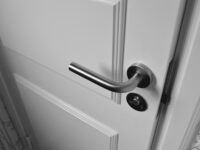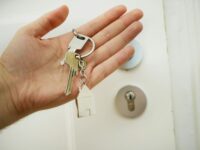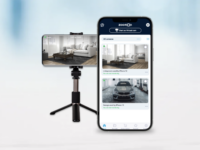The following contribution is from another author.
Home security is crucial in an era of constant threats. There are various ways to enhance home safety, such as implementing advanced security systems and following police tips. This article explores best practices for improving home security, including securing entry points, installing alarm systems and cameras, and enhancing outdoor security with motion-activated lights and smart home devices.
It also covers strategies for creating a safer environment inside the home, like using security signs and proper lighting. By the end of this guide, you’ll know how to fortify your home and maintain a secure living environment.
Secure Your Entry Points
Reinforce Doors
To keep your home secure, it’s crucial to reinforce your doors, especially the front and back entrances. Statistics show that 34% of burglars enter through the front door, making it a prime target. Install high-quality deadbolts that extend at least one inch into the doorframe to prevent easy kick-ins. For sliding glass doors, which are particularly vulnerable, add security system door sensors and glass break sensors to alert you of any intrusion attempts.
Upgrade Window Security
Windows are common entry points for criminals and often left unlocked. To enhance window security, install window or glass break sensors that detect movement and impact. Consider reinforcing glass with security film to make it more resistant to shattering. For added protection, install window bars or aftermarket window locks. Don’t forget about second-floor windows, as determined intruders may attempt to access them.
Install Smart Locks
Smart locks offer convenient keyless entry and enhanced security for your home. These advanced systems use keypads, fingerprint recognition, or facial recognition for access control. Many smart locks can be integrated with home security systems, allowing you to monitor and control your doors remotely through smartphone apps. When choosing a smart lock, consider factors like compatibility with your existing door, power requirements, and connectivity options.
Look for features such as tamper alerts and two-factor authentication to further improve your home security.
Implement a Home Security System
Choose the Right Alarm System
When it comes to home security, choosing the right alarm system is crucial. Consider factors like property size, budget, and specific security needs. Modern systems offer features like motion sensors, door/window sensors, and smart home integration. Popular options include SimpliSafe, Ring Alarm, and ADT . Systems can be self-installed or professionally installed based on preference and expertise.
Set Up Security Cameras
Security cameras are an essential component of a comprehensive home security system. They not only help deter criminals but also provide valuable evidence in case of a break-in. With security camera installation in Brisbane, consider both indoor and outdoor placement to cover all vulnerable areas. Many modern security cameras offer features like night vision, two-way audio, and smartphone connectivity, allowing you to monitor your home remotely. Popular brands like Nest, Arlo, and Ring offer a range of options to suit different needs and budgets.
Consider Professional Monitoring
While self-monitoring your security system is cost-effective, professional monitoring adds an extra layer of protection. Trained experts provide 24/7 surveillance and can alert authorities during emergencies. This service is especially valuable when you’re away or unable to respond.
However, consider the ongoing costs, which vary anywhere from 15 to 92 AUD per month depending on provider and service level.
Improve Your Outdoor Security
Install Motion-Sensor Lighting
To improve home security, install motion-sensor lighting strategically around your property, especially near entry points like doors and windows. Mount them at least 7 feet high for optimal effectiveness and to prevent tampering. Consider using dual-sensor models for more accurate detection. These lights startle potential intruders and alert you to any unusual activity outside your home.
Secure the Garage
The garage is often overlooked by burglars. Start improving security by keeping the garage door closed and locked. Install a smart garage door opener for remote monitoring and control through your smartphone. Add a deadbolt to the door connecting the garage to the house. For manual garage doors, use a padlock or C-clamp on the track to prevent forced entry.
Maintain Landscaping for Visibility
Proper landscaping is important for home security. Trim trees and shrubs near windows and doors to remove potential hiding spots for intruders. Maintain your lawn to show that the property is regularly occupied and cared for. Avoid tall, dense vegetation near the house to maintain clear sightlines from the street to your home. Consider using gravel on pathways and under windows for added security. Well-planned landscaping improves your home’s appearance and safety.
Create a Safe Environment Inside
Use Home Automation
To bolster home security, smart home devices are essential. They enable remote control of various home aspects, improving safety and convenience. For example, through platforms like Alexa and Apple HomeKit, you can manage devices using an app or voice control. Smart locks offer keyless entry and remote access control, allowing monitoring of home entry even when away. Moreover, connected smart cameras provide live feeds and send alert notifications to connected devices when detecting unusual activity.
Secure Valuables in a Safe
One of the most effective ways to protect your valuables is by using a safe. Place important items such as:
- Jewellery, cash, and important documents
- Also, consider a safety deposit box for extremely valuable items
- Create hidden storage locations in your home
Develop Emergency Plans
Creating a comprehensive emergency plan is crucial for home security. Identify risks and hazards specific to your location and household. Establish communication protocols for family members during emergencies, including meeting points and out-of-area contacts. Assign roles and responsibilities based on abilities. Develop evacuation plans with primary and secondary routes. Conduct drills to familiarize family members with emergency procedures.
Keep Your Home Secure With Our Tips!
Keeping your home secure involves a mix of smart technology and basic precautions. By beefing up entry points, setting up alarm systems, and using outdoor security measures, you can make your home a tough target for intruders. Creating a safe environment inside with home automation and emergency plans adds another layer of protection. Home security is about peace of mind. By putting these practices into action, you’re not just protecting your property, but also creating a safer haven for you and your loved ones. Remember, staying on top of your home security is an ongoing process, so it’s worth reviewing and updating your measures regularly to stay ahead of potential threats.

















This article is really helpful. It’s not redundant at all, everyone should be careful
https://geometry-dashmeltdown.co
Use our real love calculator to determine the potential of your relationship. https://love-calculator.io